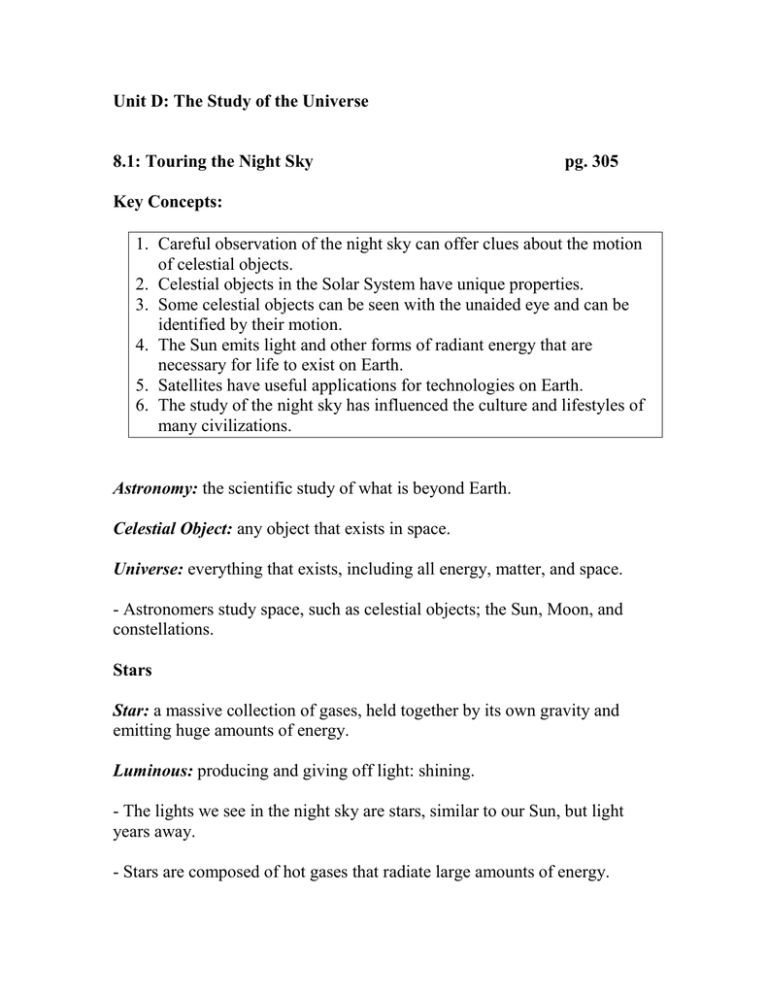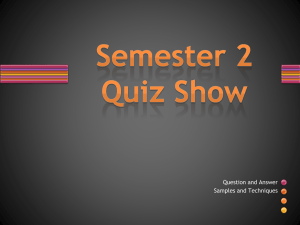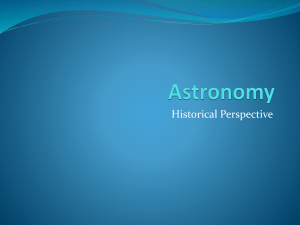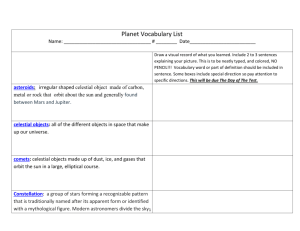Unit D: The Study of the Universe pg. 305
advertisement

Unit D: The Study of the Universe 8.1: Touring the Night Sky pg. 305 Key Concepts: 1. Careful observation of the night sky can offer clues about the motion of celestial objects. 2. Celestial objects in the Solar System have unique properties. 3. Some celestial objects can be seen with the unaided eye and can be identified by their motion. 4. The Sun emits light and other forms of radiant energy that are necessary for life to exist on Earth. 5. Satellites have useful applications for technologies on Earth. 6. The study of the night sky has influenced the culture and lifestyles of many civilizations. Astronomy: the scientific study of what is beyond Earth. Celestial Object: any object that exists in space. Universe: everything that exists, including all energy, matter, and space. - Astronomers study space, such as celestial objects; the Sun, Moon, and constellations. Stars Star: a massive collection of gases, held together by its own gravity and emitting huge amounts of energy. Luminous: producing and giving off light: shining. - The lights we see in the night sky are stars, similar to our Sun, but light years away. - Stars are composed of hot gases that radiate large amounts of energy. - We can see these stars because they are luminous, they radiate their own light. Our Star, the Sun - Our Sun is an average sized star. - In comparison to Earth, the Sun is 3.4 X 105 (340 000) times its mass and has a volume 1.3 X 106 (1 300 000) times larger. - The Sun is approximately 1.5 X 108 km away from Earth. It appears very large to us because it is close. - The nearest star to the Sun is 4.3 X 1013 km away or 300 000 times further. It appears very small. - The Sun supplies the energy that allows life to exist on our planet. - Light energy is used by plants for photosynthesis, and warms the planet. Planets Planet: a large, round celestial object that travels around a star. - Planets are celestial bodies that orbit around a star. - There are 8 that orbit the Sun. (Mercury, Venus, Earth, Mars, Jupiter, Saturn, Uranus, and Neptune) - The four planets closed to the Sun are terrestrial planets, having a hard rocky surface. - The next four planets are gaseous and also contain liquid. They are identified as gas giants. - The planets and their moons are non-luminous (do not generate their own light), they reflect light from luminous objects like our Sun. - The first five planets are visible using our naked eyes. Our Planet, Earth Solar System: the Sun and all the objects that travel around it. Satellite: a celestial object that travels around a planet or dwarf planet. Orbit: the closed path of a celestial object or satellite as it travels around another celestial object. - Earth is the third planet from the Sun. - It is the fourth largest planet in our Solar System. - Earth is in continuous motion, a terrestrial planet with diverse life forms, and water. Moons - Moons are a type of satellite, celestial object that orbits a planet. - Satellites orbit larger celestial objects, as they orbit a star. Earth’s Companion, the Moon - Moon is a natural satellite orbiting the Earth. - We can see the moon only when it is illuminated by the Sun. - The Moon is four times smaller in diameter then the Earth. - The Moon is 384 000 km away from Earth. Galaxies: Galaxy: a huge, rotating collection of gas, dust, and billions of stars, planets, and other celestial objects. - The Universe is a large collection of stars, gas, dust, and planets. - These collections of stars and planets make up billions of galaxies within the Universe. Our Galaxy, the Milky Way - Earth is found within a galaxy called the Milky Way. - Within the Milky Way there are over 200 billion stars, the Sun is only one of its stars. - Astronomers continue to study stars, planets, galaxies, and other celestial bodies. Figure 4: the Universe consist of everything that exists, including galaxies, the Solar System, celestial objects, and even you! Check Your Learning Questions 1 – 9, page 308 Summary: - Astronomy is the scientific study of what exists beyond Earth, including stars, planets, and moons. - Many celestial objects, such as stars, are visible in the night sky. Stars are luminous, whereas planets and the Moon are visible because they reflect light from the Sun. - The eight planets in t Solar System travel around the Sun. - Natural satellites, such as the Moon, orbit some planets in the Solar System. - Within the Universe there are galaxies, such as the Milky Way. Each galaxy contains billions of stars and other celestial objects.







